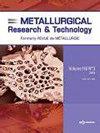Effect of strain ratio on hydrogen permeability properties of low carbon enamel steel
IF 1.1
4区 材料科学
Q3 METALLURGY & METALLURGICAL ENGINEERING
引用次数: 0
Abstract
In this study, the effect of varying strain levels on hydrogen permeability properties were investigated. Distinct strain levels (10% and 40%) were carried out on the deep drawing test samples by using Marciniak die to simulate the forming process. Amount of strain on deep drawn material was calculated by GOM’s ARAMIS 3D deformation measurement system. Hydrogen diffusion coefficient and permeation time were calculated by using Helios II system. Light optical microscope (LOM) and scanning electron microscopy (SEM) were used for microstructure characterization. Automated inclusion/precipitation analysis was performed by Thermoscientific Explorer-4. By this study, it is aimed to understand the hydrogen permeation properties of ultra-low carbon IF steel material with varying strain values. Finally, it was determined that number of inclusion/precipitation per mm2 was significantly increased as a function of strain ratio, which improves hydrogen permeation properties.应变比对低碳搪瓷钢渗氢性能的影响
在本研究中,研究了不同应变水平对渗氢性能的影响。采用Marciniak模具对拉深试验样品进行不同应变水平(10%和40%)的拉伸,模拟成形过程。利用GOM公司的ARAMIS三维变形测量系统计算了深拉材料的应变量。利用Helios II系统计算氢的扩散系数和渗透时间。采用光学显微镜(LOM)和扫描电镜(SEM)对其微观结构进行了表征。自动夹杂物/沉淀分析由Thermoscientific Explorer-4进行。本研究旨在了解不同应变值下超低碳中频钢材料的渗氢性能。结果表明,随着应变比的增加,每mm2中夹杂物/析出物的数量显著增加,从而提高了渗氢性能。
本文章由计算机程序翻译,如有差异,请以英文原文为准。
求助全文
约1分钟内获得全文
求助全文
来源期刊

Metallurgical Research & Technology
METALLURGY & METALLURGICAL ENGINEERING-
CiteScore
1.70
自引率
9.10%
发文量
65
审稿时长
4.4 months
期刊介绍:
Metallurgical Research and Technology (MRT) is a peer-reviewed bi-monthly journal publishing original high-quality research papers in areas ranging from process metallurgy to metal product properties and applications of ferrous and non-ferrous metals and alloys, including light-metals. It covers also the materials involved in the metal processing as ores, refractories and slags.
The journal is listed in the citation index Web of Science and has an Impact Factor.
It is highly concerned by the technological innovation as a support of the metallurgical industry at a time when it has to tackle severe challenges like energy, raw materials, sustainability, environment... Strengthening and enhancing the dialogue between science and industry is at the heart of the scope of MRT. This is why it welcomes manuscripts focusing on industrial practice, as well as basic metallurgical knowledge or review articles.
 求助内容:
求助内容: 应助结果提醒方式:
应助结果提醒方式:


